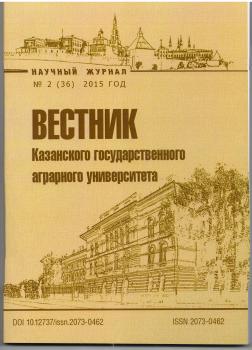This work is dedicated to the evaluation of dependence of grain and leguminous crops yield from the main agrochemical parameters of soil and weather conditions. Proceedings on agrochemical survey of arable soils, crop yields, and the main agro-meteorological indicators of Baltasi municipal district of the Republic of Tatarstan for 1980-2010 years were generalized. Over the years aproductivity of grain and leguminous crops in the region has increased for 1.73-2.25 times, increasing the yield for 37-49 kg per hectare grain per year. The productivity of all crops is most closely connected with the average content of mobile potassium (r = 0.83-0.90) and phosphorus (r = 0.51-0.78). A moderate negative correlation was found between yield of studied species and share of arable land, having an acid reaction (r = - 0.32-0.48). During the study period the moisture content of the Baltasi municipal district of Tatarstan often (recurrence is 63.4%) was characterized as insufficient or arid. We found a negative correlation of spring crops productivity (spring wheat, barley, pea) from the amount of active temperatures, which indicates that heat supply of the area is not a limiting factor for these crops, and a growing fever of the season often has a negative impact. The tightness and direction of the correlation the productivity of spring crops and peas from the amount of rainfall is changing dramatically by periods: if the amount of precipitation in May has a very weak positive effect on the productivity (r = 0.16-0.17), the rain, falling during maturation and harvesting, have a negative impact (r = -0.14 and -0.21). The largest positive impact on the spring crops yield had a rainfall of June. Especially the correlation was noticeable for pea (r = 0.64) and spring wheat (r = 0.58). Compared with the June precipitation, total precipitation during the growing season had on the yield of spring crops significantly less impact (r = 0.32-0.53). The productivity of spring crops was less dependent on the amount of annual rainfall (r = 0.28-0.49). The productivity of spring crops and peas are most closely correlated with Selyaninov hydrothermal coefficient in June (r = 0.50-0.65), and winter rye - in August before sowing (r = 0.45). Therefore, to predict the effects of the prevailing weather conditions on productivity of certain crops, it should be used the hydrothermal coefficient of Selyaninov of the relevant month. According to the yield correlation coefficients from Selyaninov hydrothermal coefficient on vulnerability to adverse weather conditions (insufficient moisture content, high temperature) experienced species can be arranged in the next growing rate: peas <spring wheat <barley <winter rye.
yield, winter rye, spring wheat, barley, peas, the amount of active temperatures, hydrothermal coefficient, rainfall, correlation, the content of mobile forms of phosphorus and potassium, soil acidity.
Урожайность сельскохозяйственных культур определяется множеством факторов, среди которых почвенные и погодные условия нередко выступают в главной роли. Сельское хозяйство это такая отрасль, которая наиболее подвержена риску, так как в огромной степени зависит от метеорологических условий [1]. Климатическая обстановка оказывает влияние на все почвенные режимы (водный, тепловой, воздушный, пищевой), определяет условия жизни сельскохозяйственных культур и использование ими питательных веществ из почвы и удобрений [2]. В связи с этим, целью нашего исследования явилась оценка влияния агрохимических параметров почв и метеорологических условий за длительный период (1980-2010 гг.) на урожайность основных зерновых и зернобобовых культур в Балтасинском муниципальном районе Республики Татарстан (РТ).Условия, материалы и методы исследований. Климатические условия Балтасинского района в целом благоприятны для сельскохозяйственного производства. Тепловые ресурсы вегетационного периода, то есть сумма температур воздуха за период с температурами выше 10°С, определяется в 20-28°С. Количество осадков за период май-сентябрь составляет 240-260 мм, причем в первую половину вегетационного периода (май-июнь) выпадает до 90 мм. В период вегетации гидротермический коэффициент более 1,0. Безморозный период достигает 130 дней, но в отдельные годы весенние заморозки могут быть и в первой декаде июня, а осенние заморозки случаются и в первой декаде сентября. Снежный покров залегает на полях в течение 150 дней с колебанием от 140 до 160 дней. Наличие достаточно мощного снежного покрова (35-45 см) при своевременном его установлении создает благоприятные условия для перезимовки озимых культур. Климат района определяется как умеренно-прохладный с достаточным увлажнением [3]. Нами обобщены и анализированы многолетние материалы агрохимического обследования пахотных почв, урожайность культур и основные метеорологические показатели: суммы активных температур выше 0; 5; 10 градусов, количество осадков, гидротермический коэффициент Селянинова за год и вегетационный период. Анализ и обсуждение результатов. Урожайность всех культур сильно колебалась по годам. Для иллюстрации отмеченного приведем урожайность ведущей зерновой культуры - яровой пшеницы (рис. 1).Как видно, за тридцатилетний период наблюдения урожайность зерна этой культуры варьировала от 0,67 до 6,03 т/га.
1. Khlevina, S. E. Zavisimost´ urozhaynosti sel´skokhozyaystvennykh kul´tur ot meteorologicheskikh usloviy v Respublike Mordoviya / S.E. Khlevina. Aktual´nye problemy geografii i geoekologii. -2012. Vyp. 1 (11). - 14 s. [Elektronnyy resurs]. - Rezhim dostupa: http://geoeko.mrsu.ru/.
2. Lebedeva, L.A. Nauchnye printsipy sistemy udobreniya s osnovami ekologicheskoy agrokhimii / L.A. Lebedeva, N.L. Edemskaya. Pod redaktsiey akademika RASKhN V.G. Mineeva. - M.: Izd-vo MGU, 2004. - S. 116.
3. Geograficheskaya kharakteristika administrativnykh rayonov Tatarskoy ASSR. - Kazan´: Izd-vo Kazanskogo universiteta, 1972. - S.36-42.
4. Muratov, M.R. Zavisimost´ urozhaynosti sel´skokhozyaystvennykh kul´tur ot intensivnosti primeneniya kaliynykh udobreniy /M.R. Muratov, M.Yu. Gilyazov. Biologicheskie i ekologicheskie problemy sovremennogo zemledeliya i rol´ agrarnoy nauki v ego razvitii: Materialy mezhdunarodnoy nauchno-prakticheskoy konferentsii. - Kazan´: Izd-vo Kazanskogo GAU, 2015. - S.56-58.
5. Selyaninov, G.T. Agroklimaticheskaya karta mira / G.T. Selyaninov. - L.: Gidrometeoizdat, 1966. - 12 s.
6. Zoidze, E.K. Modelirovanie formirovaniya vlagoobespechennosti territorii Evropeyskoy Rossii v sovremennykh usloviyakh i osnovy otsenki agroklimaticheskoy bezopasnosti / E.K. Zoidze, T.V. Khomyakova . Meteorologiya i gidrologiya. - 2006. - № 2. - S. 98-105.
7. Kolomeychenko, V.V. Rastenievodstvo / V.V. Kolomeychenko. - M.: Agrobiznestsentr, 2007. - 600 s.
8. Otzyvchivost´ zernobobovykh kul´tur na razlichnyy uroven´ mineral´nogo pitaniya pri oroshenii v lesostepi Zapadnoy Sibiri Timokhin A.Yu. //Dostizheniya nauki i tekhniki APK. 2014. № 5. S. 10-12.





